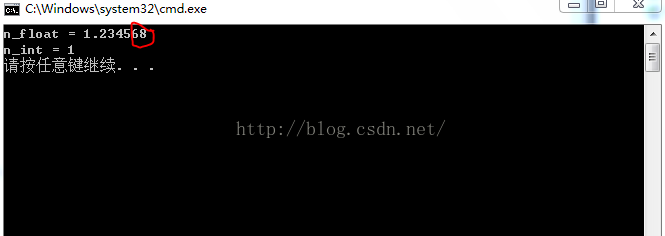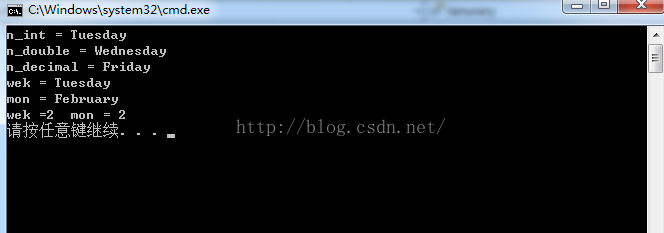C#学习日记17---显示类型转换具体用例
- 黄舟原创
- 2017-01-21 15:07:061716浏览
在C#的类型转换中,除了上一篇中介绍到的 隐式类型转换 外还有一种需要我们声明的类型转换-----显示类型转换.
显示类型转换,又叫强制类型转换,在进行转换的时候它需要我们明确的指定转换类型. 比如,当我们把long类型转换为int类型时,由于这种转换是丢失精度的转换,系统不会自动进行隐式转换,所以需要进行强制转换:
long l = 6000;
int i = (int)l; //需要用在 ()里面声明转换类型显示类型转换并非是对任意2种类型都成立,比如:
int i = 6000;
string i = (string)i; //这里会报错因此显示类型转换也是有一定规则的:
显示数值转换;
显示枚举转换;
显示引用转换;
显示转换并不是总能成功,而且常常可能引起信息的丢失(因为类型不同,范围、精度也是不同的 详情参照数据类型),显示转换包括所有的隐式转换,因此也可以把隐式转换写成显示转换的形式,比如:
int i = 6000;
long l = (long)i; //等价于 long l = i;显示数值转换:
显示数值转换,是指值类型与值类型之间的转换,有如下的规则:
从 sbyte 到 byte、ushort、uint、ulong、char类型;
从 byte 到 sbyte、char类型;
从 short 到 sbyte、byte、ushort、uint、ulong、char类型;
从 ushort 到 sbyte、byte、short 、char类型;
从 int 到 sbyte、byte、short、ushort、uint、ulong、char类型;
从 uint 到 sbyte、byte、short、ushort、int、char类型;
从 long 到 sbyte、byte、short、ushort、int、uint、ulong、char类型;
从 ulong 到 sbyte、byte、short、ushort、int、uint、long、char类型;
从 char 到 sbyte、byte、short类型;
从 float 到 sbyte、byte、short、ushort、int、uint、long、ulong、char、decimal类型;
从 double 到 sbyte、byte、short、ushort、int、uint、long、ulong、float、char、decimal类型;
从 decimal 到 sbyte、byte、short、ushort、int、uint、long、ulong、float、char、double类型;
写了这么多总结下吧,就是从高精度到低精度的转换,有可能是保留转换也有可能是四舍五入转换,写个例子:
using System;
using System.Collections.Generic;
using System.Linq;
using System.Text;
namespace Test
{
class Program
{
static void Main(string[] args)
{
double n_double = 1.73456789;
float n_float = (float)n_double; //显示转换 float的有效为只有8位(.也是一位)所以从第9位四舍五入
int n_int = (int)n_double; //只保留整数
Console.WriteLine("n_float = {0}\nn_int = {1}",n_float,n_int);
}
}
}运行结果:

对比发现当double 数据范围超出float的有效值范围,显示转换时对第9位四舍五入,转换为int类型时只保留整数部分。
显示枚举转换:
显示枚举转换包括下面几个内容:
从sbyte、byte、short、ushort、int、uint、long、ulong、float、char、double、decimal类型到任何 枚举 类型;
从任何枚举类型 到 sbyte、byte、short、ushort、int、uint、long、ulong、float、char、double、decimal类型;
从任何枚举类型 到 任何其他枚举类型;
写个列子:
using System;
using System.Collections.Generic;
using System.Linq;
using System.Text;
namespace Test
{
class Program
{
enum weekday //定义2个枚举
{Sunday,Monday,Tuesday,Wednesday,Thursday,Friday,Saturday }
enum Month
{Janurary=1,February,March,April,May,Jun,July }
static void Main(string[] args)
{
int n_int = 2;
double n_double = 3.0;
decimal n_decimal = 5m; //声明decimal 类型要加m
weekday weki = (weekday)n_int; //从int、double、decimal到枚举转换
weekday wekd = (weekday)n_double;
weekday wekde = (weekday)n_decimal;
weekday wek = weekday.Tuesday; //枚举类型之间的转换
Month mon = (Month)wek;
int i = (int)wek; //从枚举类型到int的转换
int t = (int)mon;
Console.WriteLine("n_int = {0}\nn_double = {1}\nn_decimal = {2}",weki,wekd,wekde);
Console.WriteLine("wek = {0}\nmon = {1}\nwek ={2}\tmon = {3}",wek,mon,i,t);
}
}
}运行结果:

显示引用转换:
从对象到任何引用类型的转换;
using System;
using System.Collections.Generic;
using System.Linq;
using System.Text;
namespace Test
{
class Program
{
//定义2个类 teacher与man
class teacher
{ }
class man
{ }
static void Main(string[] args)
{
man per = new man(); //将man实例化一个对象per
object o = per; //装箱
teacher p = (teacher)o; // 将o显示转换为teacher类
}
}
}从类类型s到类类型t的转换,其中s是t的基类;
using System;
using System.Collections.Generic;
using System.Linq;
using System.Text;
namespace Test
{
class Program
{
class man //定义一个基类
{ }
class student:man //student继承man
{ }
static void Main(string[] args)
{
man per = new man(); //man实例化一个对象per
student stu = (student)per; //将父类转换为子类
}
}
}从类类型s到接口t的转换,其中s不是密封类,并没有实现t;(有关接口(interface)的内容后面会写到,它只声明方法不定义方法)
using System;
using System.Collections.Generic;
using System.Linq;
using System.Text;
namespace Test
{
class Program
{
public interface teacher //定义一个接口
{ }
class student //定义一个类
{ }
static void Main(string[] args)
{
student stu = new student(); //实例化一个对象
teacher tea = (teacher)stu; // 显示转换
}
}
}从接口型s到类类型t的转换,其中t不是密封类,并没有实现s;
using System;
using System.Collections.Generic;
using System.Linq;
using System.Text;
namespace Test
{
class Program
{
public interface man //定义一个接口
{ }
class teacher:man //定义一个继承于man的类man
{ }
class student //定义一个新类
{ }
static void Main(string[] args)
{
man teac=new teacher(); //间接实例化一个接口
student stu = (student)teac; // 显示转换
}
}
}从接口类型s到接口类型t的转换,其中s不是t的子接口;
using System;
using System.Collections.Generic;
using System.Linq;
using System.Text;
namespace Test
{
class Program
{
public interface man //定义一个接口
{ }
class teacher : man //由接口派生一个类
{ }
public interface person //定义一个接口
{ }
class student:person //由接口派生一个类
{ }
static void Main(string[] args)
{
man teac=new teacher(); //间接实例化一个接口
person stu = (person)teac; // 显示转换
}
}
}引用类型数组与引用类型数组显示转换,其中两者是父类与子类的关系(维数要相同)
using System;
using System.Collections.Generic;
using System.Linq;
using System.Text;
namespace Test
{
class Program
{
class teacher
{ }
class student:teacher //studnet继承teacher
{ }
static void Main(string[] args)
{
teacher[] teac = new teacher[5];
student[] stu = new student[5];
stu = (student[])teac; //显示转换
}
}
}如果换成下面的数组就不行
using System;
using System.Collections.Generic;
using System.Linq;
using System.Text;
namespace Test
{
class Program
{
static void Main(string[] args)
{
double[] n_double = new double[5];
float[] n_float = new float[5];
n_float = (float[])n_double; //这里出错啦
}
}
}从System.Array到数组类型 (array 是所有数组类型的基类)
using System;
using System.Collections.Generic;
using System.Linq;
using System.Text;
namespace Test
{
class Program
{
static void Main(string[] args)
{
Array arr = new Array[5]; //定义一个Array类型的数组并初始化
double[] d = new double[5];
d = (double[])arr; //显示转换
}
}
}从System.Delegate到代表(委托)类型
using System;
using System.Collections.Generic;
using System.Linq;
using System.Text;
namespace Test
{
class Program
{
public static delegate int mydele(); //声明一个委托
class DE : Delegate //定义一个继承于Delegate 的类DE
{ }
static void Main(string[] args)
{
Delegate MY =new DE(); // 将Delegate 抽象类间接实例化
mydele my = (mydele)MY; //显示转换
}
}
}以上就是 C#学习日记17---显示类型转换具体用例的内容,更多相关内容请关注PHP中文网(www.php.cn)!

